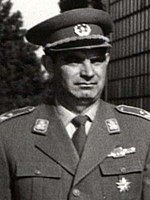Aleksandar Nikolić Hall

The Aleksandar Nikolić Hall (Serbian: Хала Александар Николић, romanized: Hala Aleksandar Nikolić), formerly known as Pionir Hall (Serbian: Хала Пионир, romanized: Hala Pionir), is an indoor sports arena located in Palilula, Belgrade, Serbia. The official seating capacity of the arena is 8,000.It was renamed in 2016 in honour of Serbian basketball player and coach Aleksandar Nikolić. The hall is well known for its frequent matches between different basketball clubs, especially Crvena Zvezda (Red Star Belgrade),Partizan, and foreign clubs. Projected by Ljiljana and Dragoljub Bakić, the hall has been described as the "architectural icon of the postmodernist Belgrade".
Excerpt from the Wikipedia article Aleksandar Nikolić Hall (License: CC BY-SA 3.0, Authors, Images).Aleksandar Nikolić Hall
Mitropolita Petra, Palilula Urban Municipality Palilula
Geographical coordinates (GPS) Address External links Nearby Places Show on map
Geographical coordinates (GPS)
| Latitude | Longitude |
|---|---|
| N 44.815516666667 ° | E 20.485111111111 ° |
Address
Хала „Александар Николић“ (Хала Александар Николић)
Mitropolita Petra
11060 Palilula Urban Municipality, Palilula
Central Serbia, Serbia
Open on Google Maps









